#if wayne put 17 on the poster then that was Intentional
Explore tagged Tumblr posts
Text
wait . i am so fucking behind on the theories i cant believe i didnt know about the eddie thing i have to reconsider so much shit
#head in my hands gripping my hair#that changes so much shit???#if two years of his life were taken that . What#clearly everyone would have had their lives recontextualized to believe eddie to be 17#but then how does dustin remember him?? he had only known him for about six ish months#if wayne put 17 on the poster then that was Intentional#unless this is meant to be simply a hint and not something experienced by other people#this would be time fuckery on another level#moving to the past in a place that is a completely separate dimension from the original dimension but the characters communicate to the#present and engage with the present#and also this past only exists as an alternate universe where time does and doesnt flow#and everything is different and its not#the events of that night arent being repeated#but they’re in the past?#man with how sloppy s4 was put together and the fact that the actors didnt even know how old their characters are this is something i might#actually believe to be a production error. especially because of how unimportant eddie is in the grand scheme of things#if it’s not an error then that is such a complex and borderline contradictry set up and for what?#they cant actually interact with the past if time is just frozen#they actively engage with the present#there is no repitition of the past occurring#sigh. i hate this show
33 notes
·
View notes
Text
Marvel's Captain Marvel: A Legacy of Failed Relaunches
This piece is about the history of the Captain Marvel name in superhero comic books. First we have to start with the originator, then how it was shut down, then we can get to how it was stolen and how it's been handled since. I will not be getting in to Miracleman/Marvelman, since that is a whole other layer of convoluted.
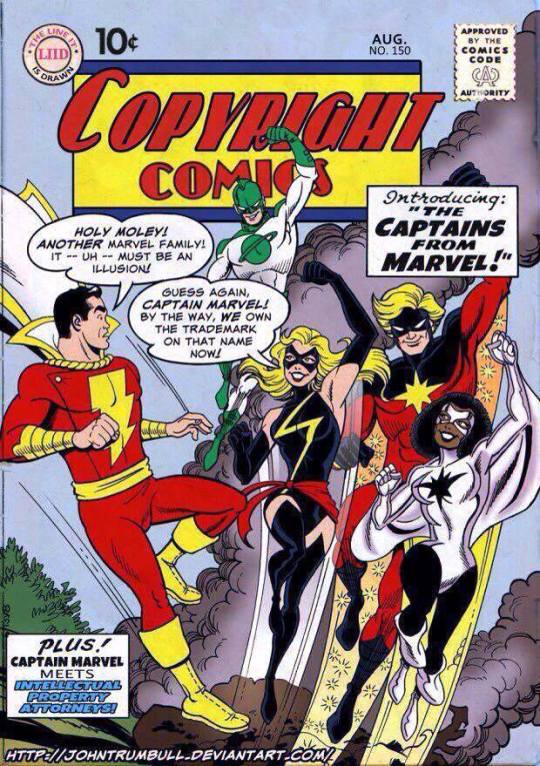
Fawcett Publications was a publisher of magazines in the 1920s and 30s. They wanted to break into the comic book business after seeing the insane success of Superman starting in 1938. So in 1940 writer Bill Parker and artist CC Beck came up with a superhero for this purpose. The character was to be called Captain Thunder and debut in Flash Comics #1. However, All-American Periodicals beat them to the punch with their own Flash Comics #1 with a cover date of January 1940, debuting the Flash, Hawkman, and other characters. So Fawcett switched the title to Thrill Comics. Which they couldn't use either when Standard/Nedor launched Thrilling Comics #1 with a cover date of February 1940. I guess even the "ing" was too close for trademark comfort. January 1940 also saw the first issue of Fiction House's Jungle Comics, which had a minor backup feature starring Captain Terry Thunder. So when their character was finally unveiled to the public, he was Captain Marvel and appearing in WHIZ Comics #2.
The parallels to Superman were there off the bat and intentional. The first cover features Captain Marvel throwing a car, in reference to the iconic Action Comics #1, but one-upping it. Their powers, costumes, and adventures were somewhat similar. Captain Marvel arguably improved on the Superman formula. Instead of the grown, nerdy Clark Kent, Captain Marvel's secret identity was the child Billy Batson. Rather than looking up to Superman, kids could put their selves in Billy Batson's shoes. The art of CC Beck and others was also more cartoony and the stories more outlandish and fun. While Superman was dealing with corrupt politicians and domestic abusers, Captain Marvel was fighting the moon and hanging out with anthropomorphic tigers.
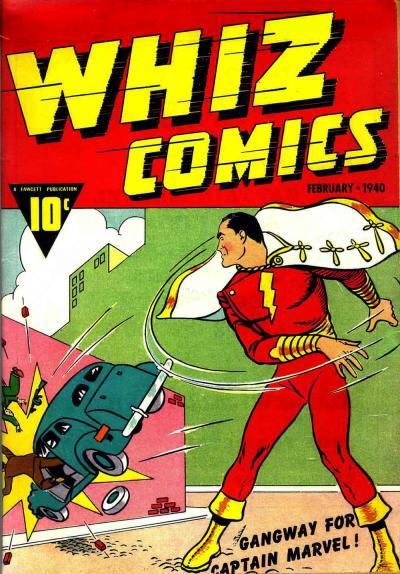
Captain Marvel replicated the success of Superman, and for a while even outsold the poster boy of comic books. The character's success led to Fawcett creating a whole line of comics and superheroes like Bulletman, Spy Smasher, Minute-Man, Ibis the Invincible and so on in the titles Nickel Comics, Wow Comics, Master Comics, etc. Captain Marvel started multiplying himself with spinoff characters Captain Marvel Jr. and Mary Marvel (before DC created Supergirl). The publisher experienced great success through the 1940s.
This success bothered some people, namely competitor National (today's DC Comics). They had success earlier shutting down Fox Feature Syndicate's character Wonder Man for being too close to Superman. They even did the same thing to Fawcett with their character Master Man. Starting in 1941 National took Fawcett to court over Captain Marvel. The lawsuit and all its subsequent appeals lasted all the way to 1951. Meanwhile Superman was ripping off elements of Captain Marvel along the way, like starting to actually fly, Lex Luthor becoming a bald mad scientist (like Dr. Sivana), and introducing the adventures of Superboy akin to Captain Marvel Jr. The long legal struggle and the waning superhero popularity of the 1950s led to Fawcett giving up on the case and shutting down their entire comics line in 1953.
Of course, having won, DC took the opportunity to pull over Fawcett's talent and put them to work on Superman. DC then ended up licensing Fawcett's characters in the 1970s. Captain Marvel has been fully integrated to the DC Universe through the years, for better or worse.
There is just one ironic hiccup though. While Captain Marvel lay dormant in the 1960s, the trademark lapsed. Another comic publisher by the name of Timely Comics had went through a few eras and name changes to Atlas Comics and then to Marvel Comics. Marvel was becoming a major force in the early 1960s thanks to Stan Lee, Jack Kirby, and Steve Ditko. Publisher Martin Goodman demanded that they snatch up the trademark to Captain Marvel. Fitting I suppose given the name of the company.
So in December 1967 Marvel's version of Captain Marvel debuted in Marvel Super-Heroes 12. Rather than a Superman-like character, this version was Mar-Vell, an alien warrior who was tasked to spy on Earth but then decided to protect humanity. The stories were light science fiction fare.
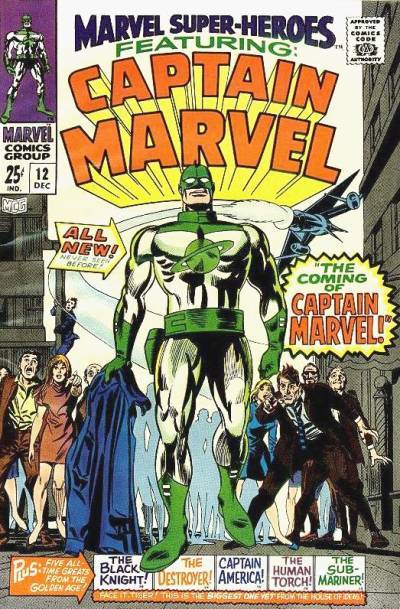
This Captain Marvel would not become a sales juggernaut like Fawcett's. Marvel has to maintain their right to the trademark at least every two years though. So this has lead to dozens of relaunches and different characters under the Captain Marvel name.
This is their legacy of failure.
After two appearances in Marvel Super-Heroes (12-13) Captain Marvel received his own self-titled comic in May 1968. From the first appearance through the fourth issue of the series, Gene Colan drew the character and Roy Thomas wrote him. Then not even a year in new creative team Arnold Drake and Don Heck hop on. Other creators like Gary Friedrich, Dick Ayers, and Archie Goodwin rotate through. The original green and white costume has a simplistic design that has become retroactively classic, but is really not too special.
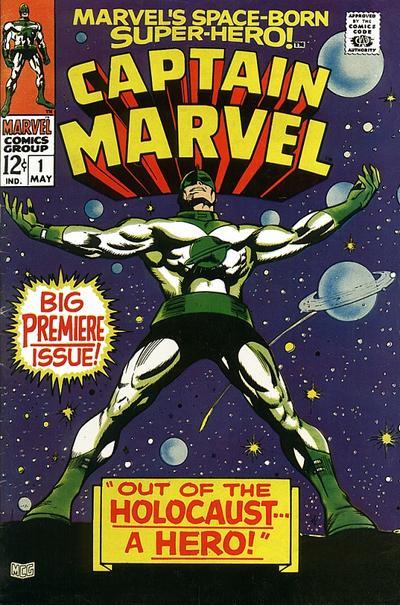
With issue 17 in October 1969, Roy Thomas comes back and is joined this time by Gil Kane. The pair introduce a new costume and the unique dynamic of Captain Marvel playing switcheroo with perennial sidekick Rick Jones. The quality of the book vastly improves, but it only gets the chance to show it off for three issues.
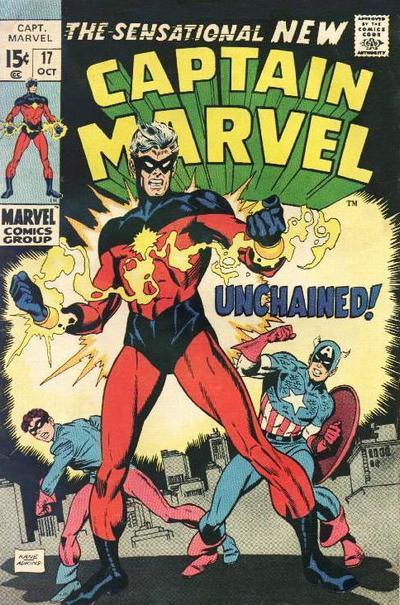
After a six month hiatus, Captain Marvel resumes with issue 20 and the same creative team from before. This time they only get to pump out two issues. The book will now be bimonthly for the most part from here on out.
The character would feature prominently in the classic Kree/Skrull War storyline in Avengers, also written by Roy Thomas. This kept him relevant through 1971 even without a book.
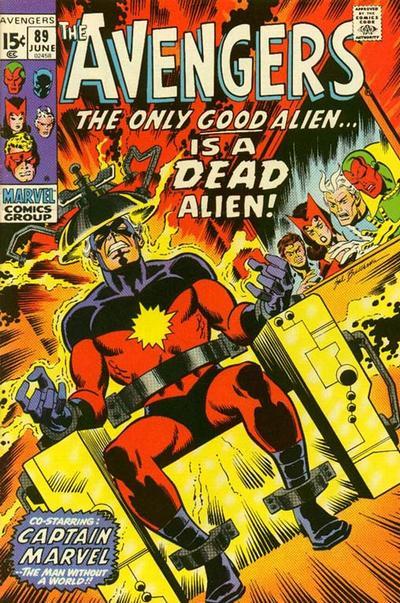
And Mar-Vell is back again two years later in 1972 (recall the trademark rules). This time we have three uninspired issues written by three different writers. The only notable piece here is that they're drawn by Wayne Boring. Who was one of the definitive Superman artists of the 1940s and 50s in comic books and strips. In 1967 DC kicked him out, as they had done with most of their iconic Golden Age artists. Super fan and historian Roy Thomas hired him to do a few jobs for Marvel in the 70s. It's cool to see, but his style honestly was out of date by this point. The irony of these past two relaunches is that both returning issues use the cover text "the hero who wouldn't die!" The irony will become evident in a bit.
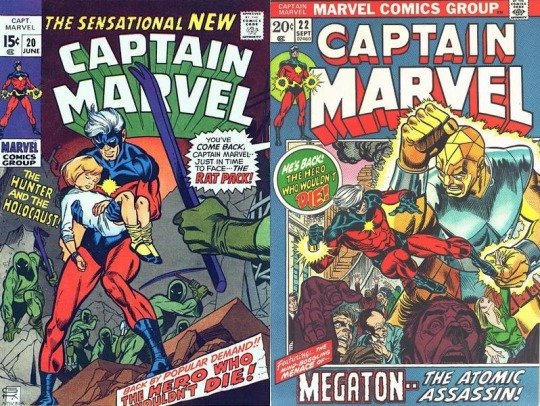
By this point DC has licensed the original Fawcett Captain Marvel. Due to Marvel's trademark usage, DC has to title the comic Shazam (the catchphrase Billy Batson uses to transform into the hero). Shazam runs from 1973 through 1978 and then the character moves to anthology backups. Superman even introduces the Big Red Cheese on the cover of the first issue. Within the pages of the comic, the character is still allowed to be called Captain Marvel. This alleged confusion has caused anxiety over the years for DC and with the New 52 reboot in 2011 they tried to officially change the icon's name to Shazam.
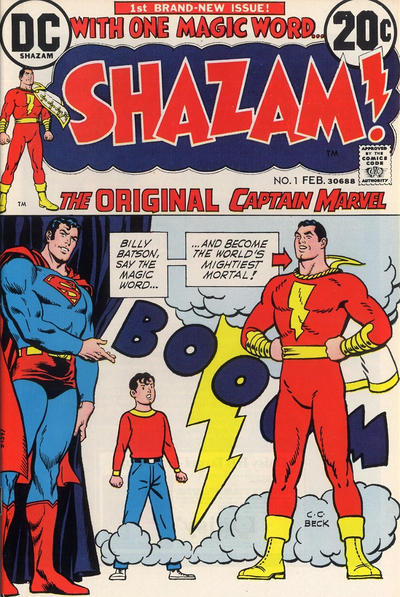
With issue 25 in 1973 Captain Marvel finally becomes a must-read comic when a young Jim Starlin jumps on board as artist. He had previously written and drawn fill-in issues of Iron Man that introduced the characters Thanos and Drax the Destroyer. He brought those characters with him and began writing as well, giving fans the iconic Thanos War arc. Starlin sticks around for less than a year. His final issue is 34, where Mar-Vell fights Nitro and the infamous cover text describes him as "the man who killed Captain Marvel." It's originally just supposed to be a sensational lie as is the tradition.
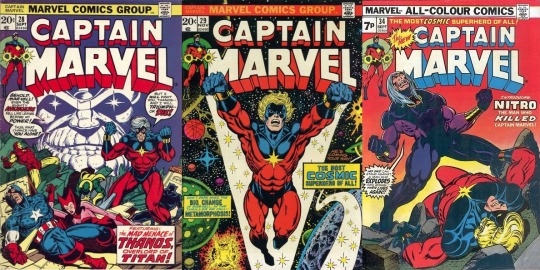
With Starlin gone, Captain Marvel still continues to issue 62 in 1979. Al Milgrom and Pat Broderick draw most of this run. Steve Englehart, Scott Edelman, and Doug Moench handle the writing. Nothing truly memorable or relevant happened, though by this point there were Mar-Vell fans who surely enjoyed it.
Supporting character Carol Danvers also got superpowers and got a spinoff title that ran two years. Mostly written by Chris Claremont. Ms. Marvel would have her own too-late creative reinvention in issue 20 thanks to artist Dave Cockrum. This book was arguably better than the book it spun out of at this point. Carol Danvers will become important again in this saga, but for the time being Claremont pulls her way to be an occasional presence in his vast X-Men run.
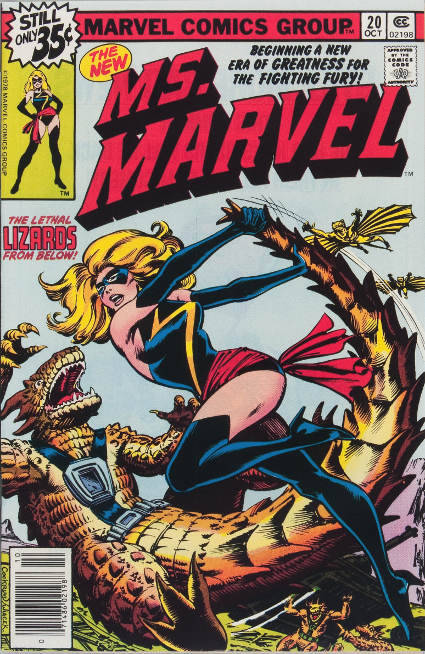
Captain Marvel was cancelled prematurely, so Marvel launched a new volume of Marvel Spotlight to pump out inventory issues. Captain Marvel appeared in Marvel Spotlight 1-4, and 8. Of curiosity is that Steve Ditko and Frank Miller drew the last two issues.
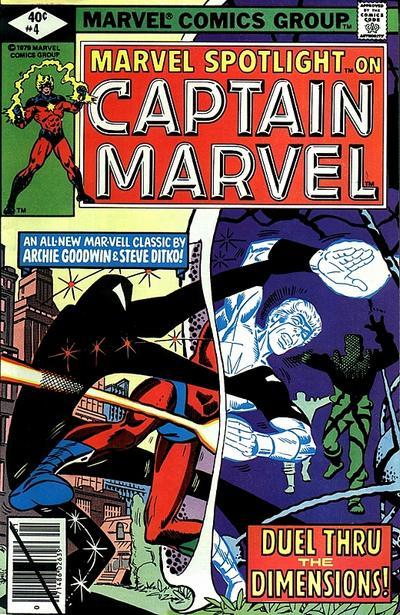
Outside of a few appearances, Mar-Vell doesn't make a major appearance between September 1980 and April 1982. When Jim Starlin was offered to write and draw the first installment of the Marvel Graphic Novel series and kill off a major character. One can presume he wasn't allowed to choose Spider-Man. He went with Captain Marvel, following up from his final issue on the series and revealing that the fight with Nitro gave him cancer. He died surrounded by all his fellow heroes and the book is a genuine emotional classic. It solidifies Mar-Vell as a legend, even if his original series never truly got him to deserve that reputation.
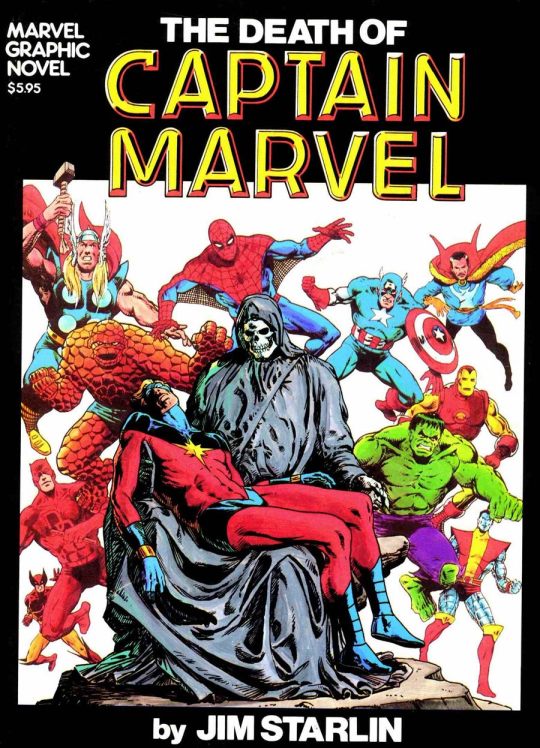
Mar-Vell would be featured in a reprint series titled The Life of Captain Marvel in 1985 focusing on the Starlin run. A three issue flashback series to his green and white era was published in 1997.
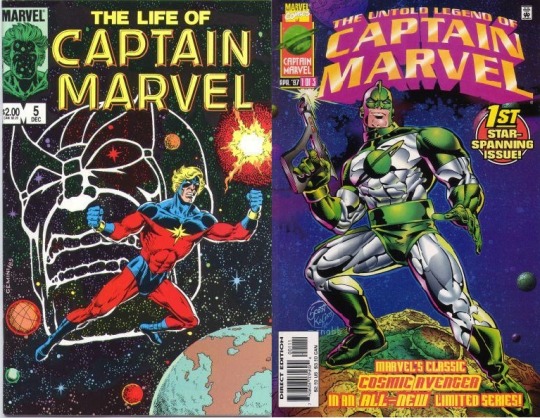
They need to maintain the trademark though, right? Enter Monica Rambeau in Amazing Spider-Man Annual #16 the same year. Her connection to Mar-Vell was nonexistent, but she took on the Captain Marvel name regardless. Creator Roger Stern carried her over to his legendary Avengers run and she even lead the team for a period. Monica has had tons of memorable appearances since, such as the brilliant Nextwave: Agents of HATE.
Monica would receive solo one-shots in 1989 and 1994. Both by the creative team of Dwayne McDuffie and M.D. Bright.
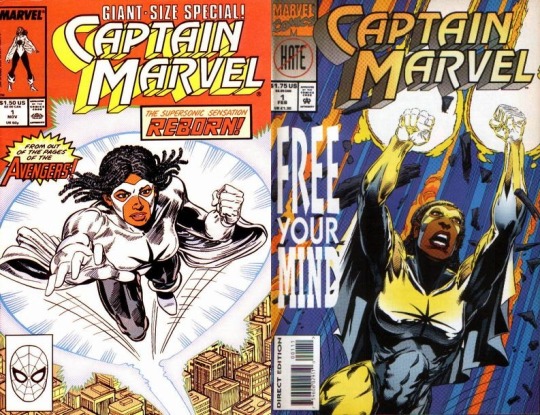
The third Marvel character to go by Captain Marvel was Genis-Vell. Originally introduced in Silver Surfer Annual #6 as Legacy, Genis is Mar-Vell's bastard child. Genis gets his father's Nega Bands and even is linked to Rick Jones. He got his own series written by Fabian Nicieza in late 1995 that was cancelled prematurely after six issues. In Avengers Unplugged #5 Genis officially takes the Captain Marvel name from Monica, who then suffers through several code names over the years.
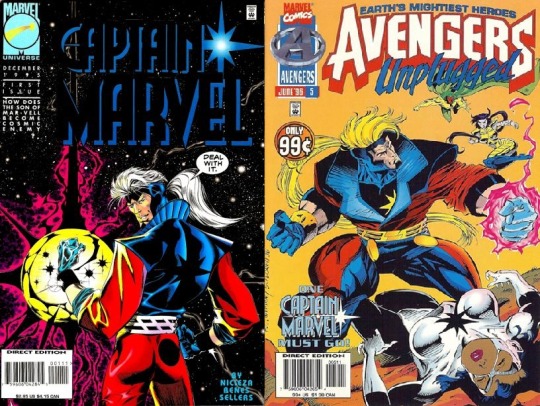
After disappearing for about two years, Genis pops up again prominently in the Avengers Forever maxiseries. This launched a 2000 series written by Peter David and drawn by ChrissCross. The series was a critical darling and cult hit, but sales weren't perfect.
To try and boost sales, the book was relaunched in 2002 as part of the U-Decide Campaign. Which was a (marketing ploy) bet between David, Bill Jemas, and Joe Quesada. Fans helped to decide which of three books would survive. It helps that the other two books (Marville and Ultimate Adventures) were absolute trash, but Captain Marvel handily won. It lasted another 25 issues to bring the entire run to 60 issues. During the run, the fourth Captain Marvel Phyla-Vell is introduced as Genis' sister/clone. She uses the name briefly and then becomes Quasar and then Martyr in other stories. Genis eventually goes crazy, then dies.

In 2008 as part of the Secret Invasion crossover, Mar-Vell seems to come back to life in a self-titled miniseries. However, it's revealed that this character is a Skrull with fake memories.
The Skrull fake dies, but is able to pass on his wishes to the Kree hero Noh-Varr. Who was previously known as Marvel Boy, but then becomes Captain Marvel during the Dark Reign era. After discovering he's being manipulated, he abandons the Dark Avengers and takes on the Protector identity.
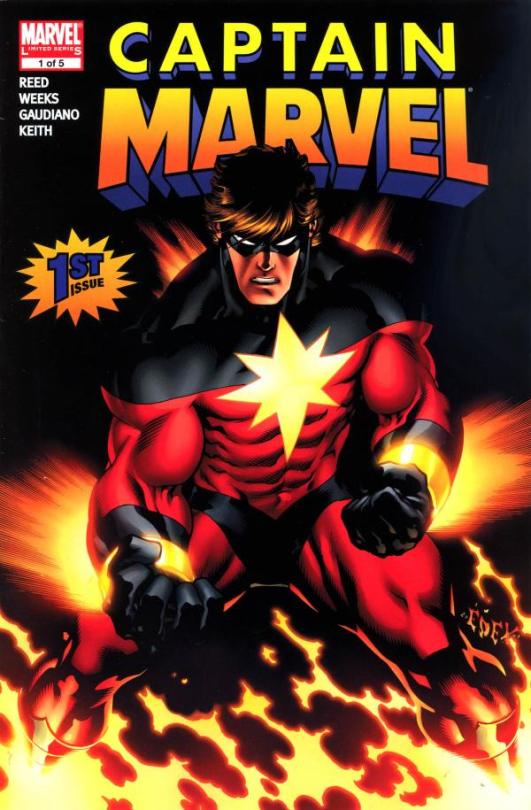
While the Avengers stock is rising in the 2000s thanks to Brian Michael Bendis, Carol Danvers is back as Ms. Marvel and her mission is to become the prominent hero she thinks she can be. To really promote her, in 2012 Marvel gives her the Captain Marvel name, redesigns her costume, and launches a new title. Kelly Sue DeConnick will shepard the character for the next few years. This series only lasts 17 issues.
By 2012 Marvel has now entered their relaunch trigger happy era. So in 2014 Captain Marvel is relaunched while keeping the same writer. This volume is even shorter at 15 issues.
As a tie-in to the alternate reality event Secret Wars in 2015, Carol Danvers gets her own miniseries still by KSD.
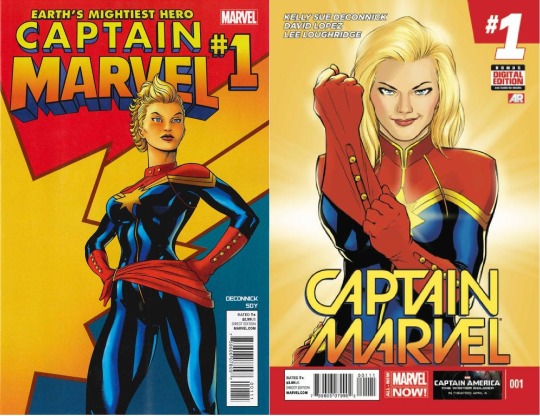
Coming out of Secret Wars, Captain Marvel gets another volume. This one lasts only 10 issues. Marvel brings in TV writers Tara Butters and Michele Fazekas. They leave halfway through and are replaced by Christos and Ruth Gage. The character is significantly entangled in the divisive crossover event Civil War II around this era.
In 2017 another relaunch is due and Carol gets the slight title change to The Mighty Captain Marvel. Prose writer Margaret Stohl is the writer. This series lasts nine issues before being renumbered/retitled as part of Marvel's Legacy initiative. Still with Stohl, renumbered for only five issues.
A soon to be released one-shot tie-in to Infinity Countdown promises Carol adventuring with Monica and possibly Mar-Vell. Marvel has been subtly teasing Mar-Vell's genuine return again recently.
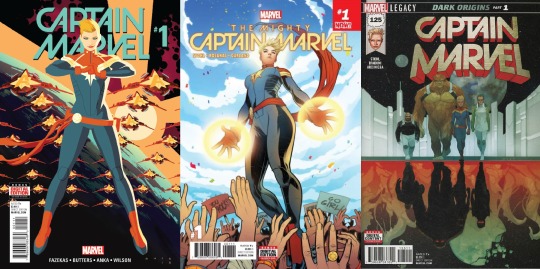
With a Captain Marvel movie starring Carol Danvers just around the corner, Marvel obviously needs to relaunch again (SIGH). July 2018 will bring The Life of Captain Marvel #1. Still written by Stohl, the series promises to retell Carol Danver's origin. So maybe they'll decide to relaunch it again after the origin arc is over.
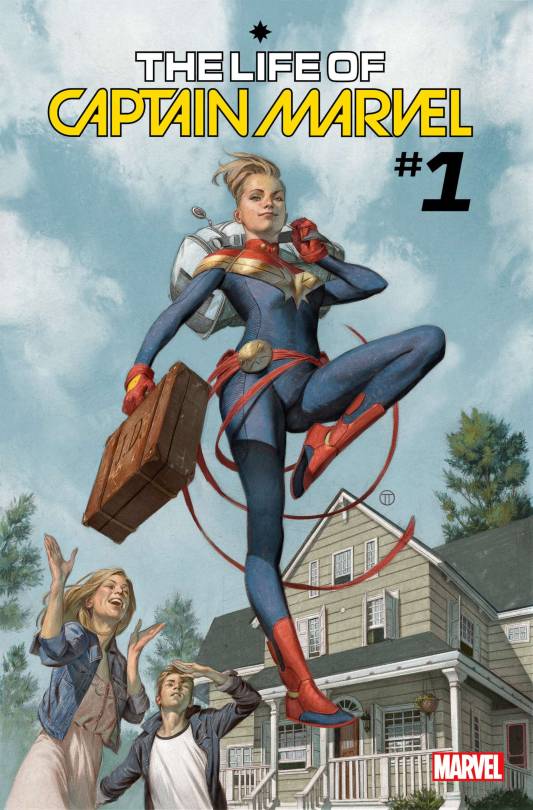
It's unclear whether DC would have been able to quickly grab the trademark back in the possibly free periods of 1984, 1987, 1992, 1998, and 2006. I don't know if the publication of collected editions fulfills the trademark requirements. If so, Masterworks and other collections could tick off some of those possible open spots.
To summarize, here are all of Marvel's Captain Marvel titles and relaunches:
Mar-Vell Marvel Super-Heroes 12-13 (December 1967-March 1968) Captain Marvel Vol 1 1-19 (May 1968-December 1969) Captain Marvel Vol 1 20-21 (June-August 1970) Captain Marvel Vol 1 22-62 (September 1972-May 1979) Marvel Spotlight 1-4, 8 (July 1979-September 1980) Death of Captain Marvel (April 1982) Life of Captain Marvel Vol 1 1-5 (August-December 1985) Untold Legend of Captain Marvel 1-3 (April-June 1997)
Monica Rambeau: Captain Marvel Vol 2 1 (November 1989) Captain Marvel Vol 2 1/2 (February 1994)
Genis-Vell: Captain Marvel Vol 3 1-6 (December 1995-May 1996) Captain Marvel Vol 4 0-35 (November 1999-October 2002) Captain Marvel Vol 5 1-25 (December 2002-September 2004)
Skrull Fake: Captain Marvel Vol 6 1-5 (January-June 2008)
Carol Danvers: Captain Marvel Vol 7 1-17 (September 2012-January 2014) Captain Marvel Vol 8 1-15 (May 2014-July 2015) Captain Marvel and the Carol Corps 1-4 (August-November 2015) Captain Marvel Vol 9 1-10 (March 2016-January 2017) Mighty Captain Marvel 0-9 (February-November 2017) Captain Marvel Vol 1 125-129 (December 2017-April 2018) Life of Captain Marvel Vol 2 1-? (September 2018-?)
*Dates used are cover dates.
#captain marvel#carol danvers#shazam#mar-vell#kree#genis-vell#monica rambeau#photon#pulsar#marvel#marvel comics#comics#comicbooks#comic books#dc#dc comics
54 notes
·
View notes